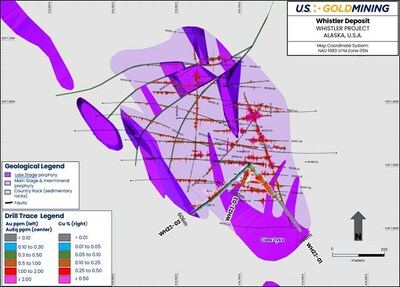U.S. GoldMining Intersects 547 meters at 1.06 g/t Gold Equivalent Including 176 meters at 1.55 g/t Gold Equivalent at the Whistler Gold-Copper Project, Alaska
Drilling Confirms Continuity of Near-Surface High-Grade Core Within Whistler Deposit
- WH23-03 intersected 547 meters at 1.06 grams per tonne (g/t) gold equivalent (AuEq), including 176 meters at 1.55 g/t AuEq.
- WH23-01 intersected 241 meters at 0.60 g/t AuEq, including 118 meters at 0.74 g/t AuEq.
- WH23-02 intersected 142 meters at 0.51 g/t AuEq, including 22 meters at 1.10 g/t AuEq.
- Assay results have increased confidence in the continuity of mineralization within the Deposit's core of high-grade mineralization which extends to surface.
- The Whistler Deposit remains open along strike and at depth, and an additional 12 targets for potential discovery of additional porphyry hosted mineralization remain untested in the Whistler-Raintree area.
- The Company plans to re-commence an approximate 10,000 meter drilling program at the Project at the start of the 2024 field season.
Alastair Still, Chairman of
Tim Smith, Chief Executive Officer of
Four drill holes were completed for a total of 2,234 meters at the Project from mid-August to mid-November, at which time the drilling program was paused for a winter break. Assay results for drill holes WH23-01, WH23-02 and WH23-03 drilled at the Whistler Deposit have been received and a summary of mineralized assay intercepts are reported in Table 1 below. Highlight intercepts are as follows:
- WH23-03 intersected 599.74 meters at 0.99 g/t AuEq* from surface (0.41 meters depth) and included 547.15 meters at 1.06 g/t AuEq, comprised of 0.77 g/t gold (Au),
0.17% copper (Cu) and 1.55 g/t silver (Ag), from 53.00 meters depth to end of hole at 600.15 meters.- Including a higher-grade intercept of 176.00 meters at 1.55 g/t AuEq from 131.00 meters depth.
- WH23-03 infilled an area of previously sparse drilling, with corresponding lower confidence resource classification, on the southern margin of the Deposit's 'high-grade core'. Assay results confirm the continuity of mineralization extending from near-surface throughout the length of the drill hole. The lower half of WH23-03 infilled an area of the Deposit currently classified as inferred in the Whistler mineral resource estimate, which may be upgraded in future iterations of the resource model.
- Mineralization intersected in WH23-03 remains open at depth, including a high-grade interval of 25.15 meters at 1.12 g/t from 575.00 meters to end of hole.
- The Company intends to deepen the hole to explore the depth extents of the Whistler mineral system in 2024.
- WH23-01 intersected 241.05 meters at 0.60 g/t AuEq, comprised of 0.33 g/t Au,
0.16% Cu and 1.86 g/t Ag, from surface (1.95 meters depth).- Including an upper high-grade intercept of 8.00 meters at 1.26 g/t AuEq from 29.00 meters depth.
- An intercept of 118.00 meters at 0.74 g/t AuEq from 77.00 meters, which includes several higher-grade zones:
- 31.0 meters at 1.00 g/t AuEq from 77.00 meters
- 19.23 meters at 1.06 g/t AuEq from 137.77 meters
- 8.00 meters at 1.16 g/t AuEq from 231.00 meters
- WH23-01 confirmed that mineralization extends to surface on the south side of the Whistler Ridge, a steep slope that presents challenges for building drill platforms and which was subsequently under-drilled in the past.
- WH23-02 intersected 142.34 meters at 0.51 g/t AuEq, comprised of 0.17 g/t Au,
0.21% Cu and 1.05 g/t Ag, from 305.00 meters depth.- Including a higher-grade zone of 22.00 meters at 1.10 g/t AuEq from 401.00 meters depth.
- WH23-02 successfully expanded the Whistler Deposit approximately 100 meters to the south of previously drilled mineralization in the southwest sector of the Deposit. Mineralization remains open to surface, to depth and south along strike. Follow-up drilling in 2024 will aim to extend the resource to surface and test for additional expansion southwards and to depth.
- WH23-04 tested the Rainmaker South target, a target external to existing mineral resources and located approximately one kilometer southeast of the Whistler Deposit. Core logging indicates the drill hole intersected a porphyry intrusive stock, confirming and validating the geophysical modeling used to target potential new porphyry stocks. Assays are currently pending; however, visual core logging indicates a lack of veining and alteration which are normally indicative of a productive porphyry intrusion.
* AuEq equations are calculated consistent with the methodology outlined in Whistler Project technical reports "S-K 1300 Technical Report Summary Initial Assessment for the Whistler Project, |
As previously reported in the Company's news release dated November 7, 2023, three diamond core drill holes: WH23-01, WH23-02 and WH23-03, for a total of 1,674 meters, were completed in 2023 from a single drill pad near the southern margin of the 800 meter by 600 meter Whistler Deposit – see Figure 1. Drill holes WH23-01 and WH23-02 targeted the southeast and southwest extents of the Deposit, respectively. WH23-03 was drilled at a steeper angle to provide additional geological data from the southern portion of the 'high-grade core' and to test for extensions below the base of the current resource model. A fourth drill hole, WH23-04 was drilled at the Raintree South target located one kilometer south of the Whistler Deposit, bringing the 2023 season total to 2,234 meters drilled. For the first time at the Project, all drill holes incorporated core orientation surveying, thereby providing important structural geometry and geotechnical data. The 2023 drill core will also provide updated information for advancing mineralogical and geometallurgical test work in 2024.
The Whistler Deposit is hosted within the Whistler Intrusive Suite, a composite suite of diorite stocks and dykes with clear cross-cutting relationships that divide the suite broadly into an early Main Stage Porphyry ("MSP"), a later Intermineral Porphyry Suite ("IMP") and a late intrusive phase referred to as Late Stage Porphyry ("LSP"). Gold and copper mineralization is characterized by abundant disseminated sulphide and quartz + sulphide vein stockworks (including classic porphyry diagnostic 'A', 'B', 'D', and 'M' type veins), and potassic alteration which is variably overprinted by later phyllic alteration. The early stage MSP suite is most strongly altered, veined and mineralized, with the IMP being less intensely altered and veined but remaining consistently mineralized, and the late or post-mineralization LSP generally being below cutoff grade or unmineralized.
The Company is working to delineate the geometry, extents and continuity of the MSP and IMP suites, which serves to focus drilling on opportunities to expand mineralization where the potentially mineralized porphyry phases remain under-explored. In addition, the technical team has identified the presence of a robust core of higher-grade mineralization within the Deposit that correlates with intense alteration and veining within the MSP. Optimizing the geological model to improve confidence in the delineation of the MSP is a key focus of the 2024 drilling program as it will improve confidence in distribution and continuity of higher-grade zones within the Deposit.
WH23-01 (see Figure 2) intersected a broad zone of gold-copper mineralization in the upper part of the Deposit, hosted within MSP and IMP and confirming the projection of the mineral resource block model to surface in a part of the Deposit that was previously poorly supported by shallow drilling on the south side of the Whistler Ridge. The drill hole also tested the location of the south-east contact of the Whistler porphyry mineral system against a post-mineral (unmineralized) stock, the 'Claw Dyke', which was unconstrained by previous drilling.
WH23-02 (see Figure 3) tested the southwest portion of the Deposit where the geological model indicated the opportunity to expand mineralized IMP southwards along strike into a part of the resource block model that is currently modelled mainly as 'waste' (below reported cutoff grade). The drill hole confirmed continuity of porphyry mineralization hosted within IMP, with assays indicating a higher copper : gold ratio than other parts of the mineral system. Core logging and preliminary white-mica mineralogy indicates this part of the porphyry system is relatively 'shallow', suggesting higher temperature and potentially more gold-rich parts of the hydrothermal system may continue at depth. Mineralization remains open to the south and at depth requiring follow-up drilling in 2024 with the aim of further extending and delineating this zone.
WH23-03 (see Figure 4) was drilled at a steep angle to improve confidence in grade continuity and achieve maximum depth penetration on the southern margin of the MSP- and IMP-hosted 'high-grade core' of the Deposit. The drill hole was designed to test for potential expansion of mineralization below the base of the current mineral resource constraining pit shell; however, drilling was terminated prematurely due to freeze-up of the water supply at the onset of winter conditions. The Company will attempt to re-enter and deepen the drill hole in 2024 to explore the depth extents of the Whistler mineral system. WH23-03 demonstrated remarkable consistency of mineralization within the 'high-grade core', with near continuous mineralization encountered from surface to end of hole and remaining open at depth. The lower half of the drill hole intersected mineral resources currently classified as inferred, thereby improving confidence in the geological model.
WH23-04 tested the Rainmaker South target, located approximately one kilometer southeast of the Whistler Deposit, intersecting a diorite porphyry intrusive stock within volcanic (andesite) country-rock. While the drill hole confirmed the geophysical modelling and targeting methodology, core logging indicates weak to absent veining and alteration which is typical of LSP suites in the Whistler area. Assays are pending; however, the Company is not expecting that the LSP drilled to date has intersected mineralization. Additional geological modeling will be completed upon receipt of assays, including multi-element geochemical 3D modelling, to establish vectors towards potential nearby mineralization at Rainmaker South. In addition to the Rainmaker South target, there are a further 12 potential targets for additional porphyry hosted mineralization in the Whistler-Raintree area.
The Company plans to re-commence drilling at the start of the 2024 field season. Additional details will be released as plans are finalized.
Visit www.usgoldmining.us for more information, including high resolution figures and to view the updated VRIFY 3D presentation which now includes the 2023 drill assays for WH23-01, WH23-02 and WH23-03.
Table 1 – Whistler Project drill assay intercepts from the 2023 drilling program received as of January 15, 2024. Bold intervals as reported in highlights above. 'Intercept Label' refers to cross-section Figures 2, 3 & 4.
Intercept | Hole | Interval | Interval | Core Length | Gold | Copper | Silver | AuEq (g/t)** |
A | WH23-01 | 1.95 | 243.00 | 241.05 | 0.33 | 0.16 | 1.86 | 0.60 |
B | Including | 29.00 | 37.00 | 8.00 | 0.82 | 0.26 | 2.40 | 1.26 |
C | Including | 77.00 | 108.00 | 31.00 | 0.56 | 0.26 | 2.46 | 1.00 |
D | Including | 77.00 | 195.00 | 118.00 | 0.44 | 0.18 | 2.12 | 0.74 |
E | Including | 137.77 | 157.00 | 19.23 | 0.75 | 0.18 | 2.73 | 1.06 |
F | Including | 231.00 | 239.00 | 8.00 | 0.77 | 0.24 | 1.35 | 1.16 |
G | WH23-02 | 305.00 | 447.34 | 142.34 | 0.17 | 0.21 | 1.05 | 0.51 |
H | Including | 379.00 | 423.00 | 44.00 | 0.29 | 0.30 | 1.51 | 0.77 |
I | Including | 401.00 | 423.00 | 22.00 | 0.42 | 0.42 | 2.33 | 1.10 |
J | Including | 415.00 | 423.00 | 8.00 | 0.51 | 0.49 | 3.25 | 1.32 |
K | WH23-03 | 0.41 | 600.15* | 599.74 | 0.71 | 0.16 | 1.54 | 0.99 |
L | Including | 53.00 | 600.15* | 547.15 | 0.77 | 0.17 | 1.55 | 1.06 |
M | Including | 131.00 | 307.00 | 176.00 | 1.24 | 0.19 | 1.66 | 1.55 |
N | And | 373.50 | 423.00 | 49.50 | 0.92 | 0.11 | 1.82 | 1.10 |
O | And | 441.00 | 457.00 | 16.00 | 1.03 | 0.20 | 1.64 | 1.36 |
P | And | 480.00 | 501.00 | 21.00 | 0.80 | 0.35 | 2.11 | 1.37 |
Q | And | 523.00 | 539.00 | 16.00 | 0.83 | 0.30 | 1.14 | 1.31 |
R | And | 575.00 | 600.15* | 25.15 | 0.86 | 0.16 | 0.93 | 1.12 |
*End of Hole |
** AuEq equations are calculated consistent with the methodology outlined in Whistler Project technical reports "S-K 1300 Technical Report Summary Initial Assessment for the Whistler Project, |
Table 2 –Whistler Project 2023 drill hole collar location coordinates.
Hole | Easting Meters | Northing | Elevation | Depth | Azimuth (Degrees) | Dip | Status |
WH23-01 | 518782 | 6871260 | 904 | 467.87 | 140.8 | - 49.0 | All assays received |
WH23-02 | 518779 | 6871253 | 902 | 605.64 | 229.2 | - 60.1 | All assays received |
WH23-03 | 518776 | 6871253 | 903 | 600.15 | 189.2 | - 82.9 | All assays received |
WH23-04 | 520197 | 6869142 | 366 | 560.83 | 134.8 | - 78.0 | Assays Pending |
Tim Smith, P.Geo., Chief Executive Officer of
For details of the Whistler Gold-Copper Project mineral resource estimate see technical report "S-K 1300 Technical Report Summary Initial Assessment for the Whistler Project,
U.S. GoldMining Inc. is an exploration and development company focused on advancing the
Except for the statements of historical fact contained herein, the information presented in this news release constitutes "forward-looking statements" within the meaning of
![]() View original content to download multimedia:https://www.prnewswire.com/news-releases/us-goldmining-intersects-547-meters-at-1-06-gt-gold-equivalent-including-176-meters-at-1-55-gt-gold-equivalent-at-the-whistler-gold-copper-project-alaska-302035406.html
View original content to download multimedia:https://www.prnewswire.com/news-releases/us-goldmining-intersects-547-meters-at-1-06-gt-gold-equivalent-including-176-meters-at-1-55-gt-gold-equivalent-at-the-whistler-gold-copper-project-alaska-302035406.html
SOURCE U.S. GoldMining Inc.











